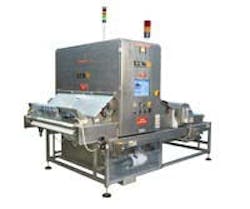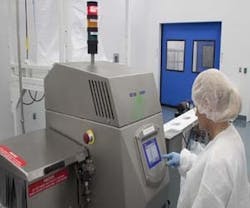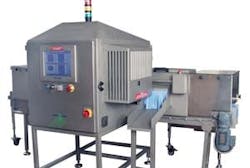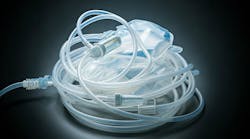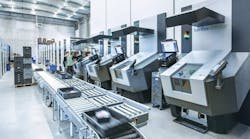With plenty of viable, affordable metal detection technologies on the market (see below), you’d think that metals contamination would be one problem drug manufacturers would have mastered. Not so, according to recent FDA warnings that show many manufacturers of powder, solid, or liquid products continue to be mystified by metal, as well as other particulates. Here are three snippets from recent letters:
- “The investigation into the source of the particles in the drug product has found the following types of particles: metal particulates, colored and transparent fibers (cotton and polyester), rubber like particles, and glass particles. The firm has not completely identified the source of all foreign matter contaminants or implemented corrective measures to reduce the foreign matter in final drug product.”
- “There were consumer complaints reporting the presence of a screw and two washers found inside a bottle of [Product A] capsules were received at your site. Other complaints reporting the presence of a foreign metal object (ejector pins from the filling/packaging line) found inside a bottle of [Product B] tablets and a bottle of [Product C] tablets were also received.”
- “Oil spots were seen on the tablets and metal shavings were found on the tablet press upon further investigation. Only the sacks of products filling at the time and two previous sacks of tablets were quarantined for metal detection. Three lots had been compressed since the last Type 1 cleaning but the firm failed to evaluate these lots."
Clearly there is some negligence going on. Good metal detection “is fairly easy to achieve,” says Bill Leonard, engineering manager at contract manufacturer and packager Pharma Tech Industries (Royston, Georgia). “But sometimes it can be cost prohibitive, requiring additional capital, or you can be tight on space to fit an extra piece of equipment in.” In addition, Leonard says, some companies may receive certification from suppliers that materials are metals-free and thus assume that the packaged product is free as well.
Over the years, Pharma Tech has purchased metal detection equipment from different vendors, all of which have done their job admirably, Leonard says. Most recently, the facility added an x-ray inspection machine from Mettler-Toledo Safeline (photo) to one of the pouching lines, per the request of a customer. The powder product is packaged in a metalized film pouch, which precluded the use of a traditional metal detector but was no problem for x-ray.
Examining X-Ray
In addition to identifying metals, X-ray detectors also track plastic, glass and other contaminants, and can be used to verify dosing portions and package integrity as well. Vendors such as Mettler-Toledo Safeline, Eriez, Thermo Fisher Scientific, and others offer a variety of shapes and sizes for various applications—from hand-helds to cabinets for large packages.
X-ray has, more than anything, given PTI peace of mind. The pouching line equipment has yet to detect any particulates since implementation, and has only a handful of times rejected product, which Leonard attributes to either system noise or perhaps a particulate that may have appeared on the outside of the pouch packages. The reject mechanism—a blast of air that removes a dummy pouch from the line—is tested at the start of each production day.
Leonard is experimenting with x-ray for mass measurement in pouching, where speed become paramount. Pharma Tech’s pouchers process approximately 80 to 90 units per minute, which can create accuracy problems for traditional checkweighers on tight-tolerance Rx products. In addition, film variability can make it difficult to automate control of package net contents. X-ray technology offers the ability to ignore the pouch material and focus on the net content’s mass, thus providing the additional safety check on dosage.
Costs and Concerns
With its ability to multitask, x-ray detection equipment carries a premium. A standard pharma device will run $65-85,000, compared to a traditional coil detector, which costs in the neighborhood of $20,000. Maintenance expenses are greater as well, Leonard notes, as tubes burn out, are fairly expensive, and must be replaced by a certified technician employed by the vendor.
Manufacturers who use x-ray technology are also subject to additional regulation. Most states have fairly rigid laws regarding the purchase and operation of x-ray equipment, Leonard notes. While pharmaceutical inspection x-rays generate power that is negligible in comparison to the machines used by hospitals and clinics, they are nevertheless usually subject to the same regulations. Georgia, for instance, requires a fair amount of paperwork upon purchase of the equipment, Leonard says, and asks that manufacturers keep records of regular maintenance and testing to show that radiation levels do not exceed what is acceptable.
It’s a training issue as well. Line operators were wary when Leonard introduced them to the new equipment, but were reassured when they learned that the radiation levels were not significant, Leonard says.
On the tabletting lines, product is inspected prior to bottling and thus traditional metal detectors have proven effective and more practical. Pharma Tech has models from different vendors in operation—having acquired them over the years to meet different customer requirements. They have proven very good for ferrous, non-ferrous and stainless steel material detection, says Leonard.
What follows is a review of new products and developments from x-ray detection vendors:
Will the cost of x-ray equipment continue to come down? Probably not, Spurgeon says. Vendors may be able to offer a low-end model for around $50,000, but will be hard-pressed to go lower due to the expenses of the x-ray technology and specialized cabinets it requires.
Among Eriez’ recent developments: a “zone detection” x-ray machine (photo), part of its EZ Tec line, that can pinpoint the area of contamination and reject a specific tablet (or tablets) rather than an entire row or more of product. “It’s very much a niche application,” Spurgeon says, but one that operators will appreciate.
Like most vendors, Thermo Fisher Scientific is taking advantage of clear advancements in x-ray technology, notes Bob Ries, Product Manager for Metal Detectors and X-Ray Systems. The tubes and photo-diode-based detectors used within newer machines have longer lives and better efficiency and accuracy, he notes. One of Thermo’s newest POWERx models has a ceramic tube which is liquid cooled, giving it double or triple the life of more traditional air-cooled tubes, Ries says. Detection sensitivity up to 0.4 mm is standard for various metals excluding aluminum, he notes.
Tubes aren’t cheap, Ries says. A typical tube from any vendor machine will last up to 15,000 hours (3 to 5 years), and replacement tubes can run from $7,000 to $20,000. With the liquid-cooled POWERx tubes, he notes, the greater initial expense is made up for by reduced tube replacement costs down the road, he says.
As x-ray detectors produce crisp images of tablets and other products, Ries gets a lot of inquiries from customers about other potential applications. (Pictured is the POWERx D double-beam machine, which performs “glass in glass” inspection.) The sky’s the limit, he says, with one caveat: usually some software customization is needed for customer-specific applications.
While Mettler-Toledo Safeline continues to offer more accurate and sensitive x-ray equipment, says Robert Scott, product manager for x-ray inspection, what matters most to clients is robustness. “They want to make sure the machine will do its job day in and day out and never fail,” he says.
Safeline continues to expand the number of machines it offers, and the applications that they handle. These include checkweighing, of course, but also inspecting pills in a blister pack card, or powder in a stick pack, and even glass in glass. This latter application is the domain of the new GlassChek Plus (photo), a four-view system that can identify shards as small as 2.5 mm3 and locate them under bottle caps and in challenging bottle crevices, Scott says.With these options and applications comes the need for customization, and so Safeline is expanding the service part of its business as well, says Scott. Rather than retrofitting their lines, customers are realizing its easier to have x-ray equipment configured for their needs in advance. Among the other features that are now available as well: UL certification and Allen-Bradley controls.
